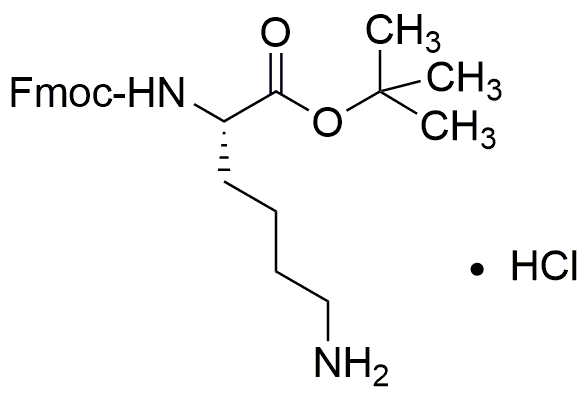Na -Fmoc-L-Lysine tert-butyl ester hydrochloride is widely utilized in research focused on:
- Peptide Synthesis: This compound is a key building block in the synthesis of peptides, particularly in solid-phase peptide synthesis (SPPS), allowing for the efficient assembly of complex peptide sequences.
- Drug Development: It serves as an important intermediate in the development of pharmaceutical compounds, especially those targeting specific biological pathways, enhancing the efficacy of drug candidates.
- Bioconjugation: The Fmoc protecting group enables selective reactions for bioconjugation, facilitating the attachment of peptides to various biomolecules, which is essential in creating targeted therapies.
- Protein Engineering: Researchers utilize this compound to modify lysine residues in proteins, improving their stability and functionality, which is crucial in the production of therapeutic proteins.
- Research in Neuroscience: Its application in the synthesis of neuropeptides aids in studying neurological functions and disorders, providing insights into potential treatments for conditions like depression and anxiety.
General Information
Properties
Safety and Regulations
Applications
Na -Fmoc-L-Lysine tert-butyl ester hydrochloride is widely utilized in research focused on:
- Peptide Synthesis: This compound is a key building block in the synthesis of peptides, particularly in solid-phase peptide synthesis (SPPS), allowing for the efficient assembly of complex peptide sequences.
- Drug Development: It serves as an important intermediate in the development of pharmaceutical compounds, especially those targeting specific biological pathways, enhancing the efficacy of drug candidates.
- Bioconjugation: The Fmoc protecting group enables selective reactions for bioconjugation, facilitating the attachment of peptides to various biomolecules, which is essential in creating targeted therapies.
- Protein Engineering: Researchers utilize this compound to modify lysine residues in proteins, improving their stability and functionality, which is crucial in the production of therapeutic proteins.
- Research in Neuroscience: Its application in the synthesis of neuropeptides aids in studying neurological functions and disorders, providing insights into potential treatments for conditions like depression and anxiety.
Documents
Safety Data Sheets (SDS)
The SDS provides comprehensive safety information on handling, storage, and disposal of the product.
Product Specification (PS)
The PS provides a comprehensive breakdown of the product’s properties, including chemical composition, physical state, purity, and storage requirements. It also details acceptable quality ranges and the product's intended applications.
Certificates of Analysis (COA)
Search for Certificates of Analysis (COA) by entering the products Lot Number. Lot and Batch Numbers can be found on a product’s label following the words ‘Lot’ or ‘Batch’.
Numéro de catalogue
Numéro de lot/série
Certificates Of Origin (COO)
This COO confirms the country where the product was manufactured, and also details the materials and components used in it and whether it is derived from natural, synthetic, or other specific sources. This certificate may be required for customs, trade, and regulatory compliance.
Numéro de catalogue
Numéro de lot/série
Safety Data Sheets (SDS)
The SDS provides comprehensive safety information on handling, storage, and disposal of the product.
DownloadProduct Specification (PS)
The PS provides a comprehensive breakdown of the product’s properties, including chemical composition, physical state, purity, and storage requirements. It also details acceptable quality ranges and the product's intended applications.
DownloadCertificates of Analysis (COA)
Search for Certificates of Analysis (COA) by entering the products Lot Number. Lot and Batch Numbers can be found on a product’s label following the words ‘Lot’ or ‘Batch’.
Numéro de catalogue
Numéro de lot/série
Certificates Of Origin (COO)
This COO confirms the country where the product was manufactured, and also details the materials and components used in it and whether it is derived from natural, synthetic, or other specific sources. This certificate may be required for customs, trade, and regulatory compliance.


